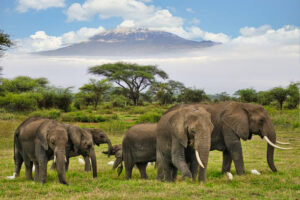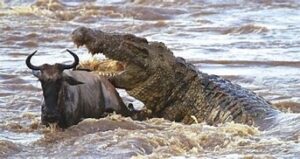Visiting the wildebeest migration in the Masai Mara National Park as opposed to the Serengeti National Park offers unique and captivating experience. For both wildlife enthusiasts and adventurers alike. Even though both parks are renowned for their stunning landscapes and diverse wildlife. There are distinct advantages to choosing the latter for witnessing this awe-inspiring natural phenomenon. In this exploration, we’ll delve into the reasons why visiting the wildebeest migration in the Masai Mara can provide a richer and more memorable experience compared to the Serengeti.
Location and Accessibility of Masai Mara:
The Masai Mara National Park is located in Kenya, while the Serengeti National Park is situated in Tanzania. As you are coming from Nairobi, the latter is more accessible, with shorter travel times by road or air. this is crucial in case you have limited time
Additionally, the Masai Mara is relatively compact compared to the vast expanse of the Serengeti. This means that wildlife sightings, including the wildebeest migration, can be easier to track, hence enhancing your overall experience.
Timing of the Migration:
The timing of the wildebeest migration varies slightly between these parks due to seasonal changes and ecological factors. While the migration is a continuous cycle of movement between the two parks, but the timing differs.
Generally, the migration reaches Kenya between July and October, coinciding with the dry season when water sources become scarce in the Serengeti. Witnessing the dramatic river crossings of wildebeest as they navigate through crocodile-infested waters shall be your highlight.
River Crossings:
One of the most exhilarating spectacles during the wildebeest migration is the river crossings, where thousands of animals brave the treacherous waters of crocodile-infested rivers such as the Mara River. The Masai Mara is renowned for its dramatic river crossings. It offers you unparalleled opportunities to witness this natural phenomenon up close.
While river crossings also occur in the Serengeti, the geography and river systems in the Kenya often result in more frequent and accessible crossings for visitors. This shall lead to more consistent and thrilling wildlife encounters during the migration season.
Predator Prey Interactions at Masai Mara:
The wildebeest migration is not only a spectacle of mass movement but also a prime opportunity to witness predator-prey interactions in the wild. In the Masai Mara, the presence of large populations of lions, cheetahs, leopards, and other predators adds another layer of excitement to the migration experience.
The open savannah landscapes of the Masai Mara provide excellent visibility for observing predator hunts and kills. it offers you a front-row seat to the circle of life in the African wilderness. This heightened predator activity can make it a more dynamic and thrilling destination for wildlife enthusiasts.
Cultural Experiences at Masai Mara:
Beyond the wildlife, visiting the Masai Mara provides you with opportunities to engage with the local Maasai communities and experience their rich cultural heritage firsthand. Many lodges and camps in the Masai Mara offer cultural visits and interactions with Maasai warriors. It provides insight into their traditional way of life, ceremonies, and crafts.
Immersing oneself in Maasai culture adds depth and authenticity to the safari experience. It allows you to appreciate the interconnectedness of wildlife conservation and indigenous communities in East Africa.
Conservation Initiatives:
Both of them are vital ecosystems facing conservation challenges such as habitat loss, poaching, and human-wildlife conflict. However, the Masai Mara has been the focus of various conservation initiatives aimed at preserving its biodiversity and ensuring the sustainability of the wildebeest migration.
Visiting it and supporting responsible tourism practices, you can contribute directly to conservation efforts and community development projects in the region. This sense of environmental stewardship and ethical tourism adds meaning to the safari experience. It also fosters a sense of responsibility towards protecting Africa’s natural heritage.
In conclusion:
Both these parks offer you a remarkable opportunity to witness the wildebeest migration. However, choose Masai Mara shall provide a more immersive, accessible, and enriching experience for you. From the adrenaline-pumping river crossings to the vibrant cultural encounters with the Maasai people. It offers you a blend of wildlife spectacle, cultural immersion, and conservation engagement. This sets it apart as a premier destination for experiencing the wonders of the African wilderness. Whether you’re a seasoned safari enthusiast or embarking on your first African adventure, Masai Mara offer you a better experience




